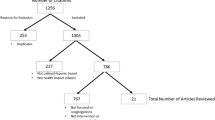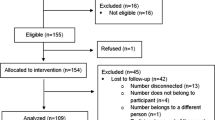Abstract
Using the right messaging strategies, churches can help promote behavior change. Frequencies of disease-specific messages in 21 African-American churches were compared to overall and cancer-specific mortality and morbidity rates as well as church-level variables. Disease messages were found in 1025 of 2166 items. Frequently referenced topics included cancer (n = 316), mental health conditions (n = 253), heart disease (n = 246), and infectious diseases (n = 220). Messages for lung and colorectal cancers appeared at low frequency despite high mortality rates in African-American communities. Season, church size, and denomination showed significant associations with health messages. Next steps include testing messaging strategies aimed at improving the health of churchgoing communities.
Similar content being viewed by others
References
American Cancer Society. (2014). Cancer awareness calendar 2014. Retrieved February 20, 2014, from http://www.cancer.org/aboutus/whoweare/cancer-awareness-calendar.
American Society of Hematology. (2011). September is national sickle cell awareness month. Retrieved April 2, 2014, from http://www.hematology.org/Advocacy/Policy-News/2011/938.aspx.
Armstrong, K., McMurphy, S., Dean, L. T., Micco, E., Putt, M., Halbert, C. H., et al. (2008). Differences in the patterns of health care system distrust between blacks and whites. Journal of General Internal Medicine, 23(6), 827–833.
Austin, A., & Harris, G. (2010). Addressing health disparities: The role of an African American Health Ministry Committee. Social Work in Public Health, 26(1), 123–135. doi:10.1080/10911350902987078.
Baruth, M., Wilcox, S., Laken, M., Bopp, M., & Saunders, R. (2008). Implementation of a faith-based physical activity intervention: Insights from church health directors. Journal of Community Health, 33, 304–312.
Bergamo, C., Lin, J. J., Smith, C., Lurslurchachai, L., Halm, E. A., Powell, C. A., et al. (2013). Evaluating beliefs associated with late-stage lung cancer presentation in minorities. Journal of Thoracic Oncology, 8, 12–18.
Campbell, M. K., Hudson, M. A., Resnicow, K., Blakeney, N., Paxton, A., & Baskin, M. (2007). Church-based health promotion interventions: Evidence and lessons learned. Annual Review of Public Health, 28, 213–234.
Campbell, M. K., James, A., Hudson, M. A., Carr, C., Jackson, E., Oates, V., et al. (2004). Improving multiple behaviors for colorectal cancer prevention among African American church members. Health Psychology, 23(5), 492–502.
Carpenter, C. (2010). A meta-analysis of the effectiveness of health belief model variables in predicting behavior. Health Communication, 25, 661–669. doi:10.1080/10410236.2010.521906.
Carroll, J. (2006). God’s Potters. Grand Rapids, MI: William B. Eerdmans.
Carter-Edwards, L., Hooten, E. G., Bruce, M. A., Toms, F., Lloyd, C. L., & Ellison, C. (2012). Pilgrimage to wellness: An exploratory report of rural African American clergy perceptions of church health promotion capacity. Journal of Prevention and Intervention in the Community, 40, 194–207. doi:10.1080/10852352.2012.680411.
Carter-Edwards, L., Jallah, Y. B., Goldmon, M. V., Roberson Jr, J. T., & Hoyo, C. (2006). Key attributes of health ministries in African American Churches: An exploratory survey. North Carolina Medical Journal, 67(5), 345–350.
Centers for Disease Control and Prevention. (2009). Behavioral risk factor surveillance system: Prevalence and trends data South Carolina. Retrieved August 7, 2014, from http://apps.nccd.cdc.gov/brfss/page.asp?yr=2009&state=SC&cat=OB#OB.
Centers for Disease Control and Prevention. (2011). Fact Sheet: CDC health disparities and inequalities report—U.S., 2011, Atlanta, GA. Retrieved from www.cdc/gov/mmwr.
DeHaven, M. J., Hunter, I. B., Wilder, L., Walton, J. W., & Berry, J. (2004). Health programs in faith-based organizations: Are they effective? American Journal of Public Health, 94(6), 1030–1036.
Foster, M. L., Arnold, E., Rebchook, G., & Kegeles, S. M. (2011). ‘It’s my inner strength’: Spirituality, religion and HIV in the lives of young African American men who have sex with men. Culture, Health and Sexuality, 13(9), 1103–1117. doi:10.1080/13691058.2011.600460.
Gordon, J. (2002). Beyond knowledge: Guidelines for effective health promotion messages. Journal of Extension, 40(6). http://www.joe.org/joe/2002december/a7.php.
Green, B. L., Lewis, R. K., Wang, M. Q., Person, S., & Rivers, B. (2004). Powerlessness, destiny, and control: The influence on health behaviors of African Americans. Journal of Community Health, 29(1), 15–27.
Griffith, K. A., Passmore, S. R., Smith, D., & Wenzel, J. (2012). African Americans with a family history of colorectal cancer: Barriers and facilitators to screening. Oncology Nursing Forum, 39(3), 299–306.
Hankerson, S. H., & Weissman, M. M. (2012). Church-based health programs for mental disorders among African Americans: A review. Psychiatric Services, 63, 243–249. doi:10.1176/appi.ps.201100216.
Harmon, B. E., Blake, C. E., Armstead, C. A., & Hebert, J. R. (2013). Intersection of identities. Food, role, and the African-American pastor. Appetite, 67, 44–52. doi:10.1016/j.appet.2013.03.007.
Harmon, B. E., Blake, C. E., Thrasher, J. F., & Hebert, J. R. (2014a). An evaluation of diet and physical activity messaging in African American churches. Health Education and Behavior, 41(2), 216–225. doi:10.1177/1090198113507449.
Harmon, B. E., Kim, S.-H., Blake, C. E., & Hebert, J. R. (2014b). Health care information in African American churches. Journal of Health Care for the Poor and Underserved, 25(1), 242–256. doi:10.1353/hpu.2014.0047.
Hebert, J. R., Wirth, M., Davis, L., Davis, B., Harmon, B. E., Hurley, T. G., et al. (2013). C-reactive protein levels in African Americans. American Journal of Preventive Medicine, 45(4), 430–440. doi:10.1016/j.amepre.2013.05.011.
Hegwer, L. R. (2013). A faith-based, data-driven partnership to improve community health. Retrieved from Healthcare Financial Management Association website: http://www.hfma.org/Content.aspx?id=18419.
James, A. S., Campbell, M. K., & Hudson, M. A. (2002). Perceived barriers and benefits to colon cancer screening among African Americans in North Carolina: How does perception relate to screening behavior? Cancer Epidemiology, Biomarkers and Prevention, 11, 529–534.
Luque, J. S., Tyson, D. M., Markossian, T., Lee, J., Turner, R., Proctor, S., et al. (2011). Increasing cervical cancer screening in a Hispanic migrant farmworker community through faith-based clinical outreach. Journal of Lower Genital Tract Diseases, 15(3), 200–204. doi:10.1097/LGT.0b013e318206004a.
Mamiya, L. (2006). River of struggle, river of freedom: Trends among black churches and black pastoral leadership Pulpit and Pew Research on Pastoral Leadership. Durham, NC: Duke Divinity School.
National Institutes of Health. (2013). Fact sheet: Health disparities. Retrieved from http://report.nih.gov/NIHfactsheets/ViewFactSheet.aspx?csid=124.
Pickard, J. G., Inoue, M., Chadiha, L. A., & Johnson, S. (2011). The relationship of social support to African American caregivers’ help-seeking for emotional problems. Social Service Review, 85(2), 246–265. doi:10.1086/660068.
Rosenstock, I. M., Strecher, V. J., & Becker, M. H. (1988). Social learning theory and the health belief model. Health Education Quarterly, 15(2), 175–183.
Rowland, M. L., & Isaac-Savage, E. P. (2013). As I See It: A study of African American Pastors’ views on health and health education in the black church. Journal of Religion and Health,. doi:10.1007/s10943-013-9705-2.
Ruo, B., Rumsfeld, J. S., Hlatky, M. A., Liu, H., Browner, W. S., & Whooley, M. A. (2003). Depressive symptoms and health-related quality of life: The heart and soul study. Journal of the American Medical Association, 290(2), 215–221.
Schiavo, R. (2014). Health communication: From theory to practice (2nd ed.). San Francisco, CA: Jossey-Bass.
South Carolina Department of Health and Environmental Control. (2009). SC Community Assessment Network: Cancer Incidence (1996–2009) and Cancer Mortality (1996–2009). Retrieved March 25, 2014, from http://scangis.dhec.sc.gov/scan/.
South Carolina Department of Health and Environmental Control. (2010a). South Carolina 2009–2010 influenza season summary report. Retrieved August 4, 2014, from http://www.scdhec.gov/Health/DiseasesandConditions/InfectiousDiseases/Flu/FluData/.
South Carolina Department of Health and Environmental Control. (2010b). South Carolina vital and morbidity statistics 2010. Retrieved August 4, 2014, from http://www.scdhec.gov/Health/SCPublicHealthStatisicsMaps/BiostatisticsPublications/.
South Carolina Department of Health and Environmental Control. (2011). South Carolina influenza surveillance report: 2010–2011 influenza season summary. Retrieved August 4, 2014, from http://www.scdhec.gov/Health/DiseasesandConditions/InfectiousDiseases/Flu/FluData/.
Stewart, J. M., & Dancy, B. L. (2012). Factors contributing to the development of an HIV ministry within an African American Church. Journal of the Association of Nurses in AIDS Care, 23(5), 419–430. doi:10.1016/j.jana.2011.09.008.
Taylor, R. J., Ellison, C. G., Chatters, L. M., Levin, J. S., & Lincoln, K. D. (2000). Mental health services in faith communities: The role of clergy in black churches. Social Work, 45(1), 73–87.
Tu, H. T., & Cohen, G. R. (2008). Striking jump in consumers seeking health care information. Results from the community tracking study. Centers for Studying Health System Change.
University of South Carolina—Cancer Prevention and Control Program. (n.d.). South Carolina cancer disparities community network. Retrieved March 7, 2014, from http://sccdcn.sph.sc.edu/.
Wakefield, M. A., Laoken, B., & Hornik, R. C. (2010). Use of mass media campaigns to change health behavior. Lancet, 376, 1261–1271. doi:10.1016/S0140-6736(10)60809-4.
Watson, D. W., Bisesi, L., Tanamly, S., Sim, T., Branch, C. A., & Williams III, E. (2003). The role of small and medium-sized African-American churches in promoting healthy life styles. Journal of Religion and Health, 42(3), 191–200.
Whiters, D. L., Santibanez, S., Dennison, D., & Clark, H. W. (2010). A case study in collaboration with Atlanta-based African-American churches: A promising means for reaching inner-city substance users with rapid HIV testing. Journal of Evidence-Based Social Work, 7, 103–114. doi:10.1080/15433710903175981.
Wilcox, S., Laken, M., Bopp, M., Gethers, O., Huang, P., McClorin, L., et al. (2007). Increasing physical activity among church members community-based participatory research. American Journal of Preventive Medicine, 32(2), 131–138.
Williams, R. M., Glanz, K., Kegler, M. C., & Davis, E., Jr. (2009). A study of rural church health promotion environments: Leaders’ and members’ perspectives. Journal of Religion and Health, 51(1), 148–160. doi:10.1007/s10943-009-9306-2.
Yanek, L. R., et al. (2001). Project Joy: Faith based cardiovascular health promotion for African American women. Public Health Reports, 116(Suppl 1), 68–81. doi:10.1093/phr/116.S1.68.
Acknowledgments
This work was supported by the National Institutes of Health, National Center on Minority and Health and Health Disparities Grant No. 1R24MD002769-01, an Established Investigator Award in Cancer Prevention and Control from the Cancer Training Branch of the National Cancer Institute to J. R. Hébert (K05 CA136975), and support from a National Cancer Institute Cancer Education and Career Development Program for B. E. Harmon (R25 CA098566).
Author information
Authors and Affiliations
Corresponding author
Rights and permissions
About this article
Cite this article
Harmon, B.E., Chock, M., Brantley, E. et al. Disease Messaging in Churches: Implications for Health in African-American Communities. J Relig Health 55, 1411–1425 (2016). https://doi.org/10.1007/s10943-015-0109-3
Published:
Issue Date:
DOI: https://doi.org/10.1007/s10943-015-0109-3




